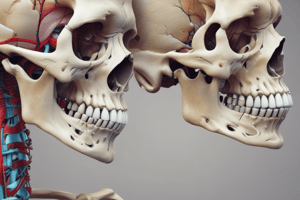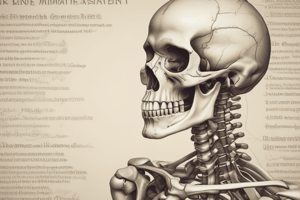Podcast
Questions and Answers
Which of the following is NOT a primary function of the skeletal system?
Which of the following is NOT a primary function of the skeletal system?
- Movement
- Support
- Hormonal regulation (correct)
- Protection
Where is yellow marrow primarily located in the body?
Where is yellow marrow primarily located in the body?
- Marrow cavity in long bones (correct)
- Within the ribcage
- Inside the skull
- Ends of long bones
What is another name for bone tissue?
What is another name for bone tissue?
- Osseous tissue (correct)
- Muscle tissue
- Adipose tissue
- Cartilage
Which part of the body is primarily protected by the ribcage?
Which part of the body is primarily protected by the ribcage?
What are epiphyseal plates primarily composed of?
What are epiphyseal plates primarily composed of?
At what age range do male epiphyseal plates typically change to epiphyseal lines?
At what age range do male epiphyseal plates typically change to epiphyseal lines?
What is the main function of red marrow?
What is the main function of red marrow?
Where is articular cartilage located?
Where is articular cartilage located?
Which structure is found on the outer side of the knee joint?
Which structure is found on the outer side of the knee joint?
Which two bones articulate at the knee joint?
Which two bones articulate at the knee joint?
What is the primary function of the periosteum?
What is the primary function of the periosteum?
Which statement accurately describes spongy bone?
Which statement accurately describes spongy bone?
Where are osteocytes located?
Where are osteocytes located?
Which structure is primarily responsible for the transport of nutrients within compact bone?
Which structure is primarily responsible for the transport of nutrients within compact bone?
What is the primary role of concentric lamellae in bone structure?
What is the primary role of concentric lamellae in bone structure?
What is the initial material that undergoes endochondral ossification?
What is the initial material that undergoes endochondral ossification?
Which cells are primarily responsible for forming new bone during intramembranous ossification?
Which cells are primarily responsible for forming new bone during intramembranous ossification?
What occurs during the secondary phase of endochondral ossification?
What occurs during the secondary phase of endochondral ossification?
Which of the following statements about mesenchymal stem cells (MSC) is true?
Which of the following statements about mesenchymal stem cells (MSC) is true?
At what stage does the spongy bone formation and the secondary ossification center appear?
At what stage does the spongy bone formation and the secondary ossification center appear?
What process allows nutrients and wastes to travel through the environment surrounding osteocytes?
What process allows nutrients and wastes to travel through the environment surrounding osteocytes?
Where are osteocytes primarily located?
Where are osteocytes primarily located?
Which of the following best describes the function of osteoclasts?
Which of the following best describes the function of osteoclasts?
At what stage does skeletal growth begin during human development?
At what stage does skeletal growth begin during human development?
What type of cartilage is primarily present in the embryonic skeleton?
What type of cartilage is primarily present in the embryonic skeleton?
What is the primary function of the diaphysis in a long bone?
What is the primary function of the diaphysis in a long bone?
Which of the following bones is classified as a short bone?
Which of the following bones is classified as a short bone?
What covers the epiphyses of a long bone to facilitate smooth joint movement?
What covers the epiphyses of a long bone to facilitate smooth joint movement?
Which of the following statements about yellow bone marrow is true?
Which of the following statements about yellow bone marrow is true?
What type of bones are the vertebrae classified as?
What type of bones are the vertebrae classified as?
What is the role of nutrient arteries in bone physiology?
What is the role of nutrient arteries in bone physiology?
Which structure is composed of dense, hard outer bone?
Which structure is composed of dense, hard outer bone?
Which part of a long bone contains trabeculae?
Which part of a long bone contains trabeculae?
Flashcards
Epiphyseal plate
Epiphyseal plate
Hyaline cartilage found in growing bones, responsible for lengthening of bones.
Epiphyseal line
Epiphyseal line
Solid, compact bone replacing the epiphyseal plate after bone growth is complete.
Articular cartilage
Articular cartilage
Smooth, white cartilage covering joint surfaces, reducing friction and providing cushioning.
Meniscus
Meniscus
Signup and view all the flashcards
Knee joint
Knee joint
Signup and view all the flashcards
Osseous Tissue
Osseous Tissue
Signup and view all the flashcards
Diaphysis
Diaphysis
Signup and view all the flashcards
Epiphyses
Epiphyses
Signup and view all the flashcards
Yellow Marrow
Yellow Marrow
Signup and view all the flashcards
Red Marrow
Red Marrow
Signup and view all the flashcards
Marrow Cavity
Marrow Cavity
Signup and view all the flashcards
Periosteum
Periosteum
Signup and view all the flashcards
Endosteum
Endosteum
Signup and view all the flashcards
Lacunae
Lacunae
Signup and view all the flashcards
Canaliculi
Canaliculi
Signup and view all the flashcards
Bone Marrow
Bone Marrow
Signup and view all the flashcards
Compact bone
Compact bone
Signup and view all the flashcards
Spongy bone
Spongy bone
Signup and view all the flashcards
Intramembranous ossification
Intramembranous ossification
Signup and view all the flashcards
Endochondral ossification
Endochondral ossification
Signup and view all the flashcards
Primary ossification center
Primary ossification center
Signup and view all the flashcards
Secondary ossification center
Secondary ossification center
Signup and view all the flashcards
Mesenchymal stem cells (MSCs)
Mesenchymal stem cells (MSCs)
Signup and view all the flashcards
Haversian Canal
Haversian Canal
Signup and view all the flashcards
Osteoclast
Osteoclast
Signup and view all the flashcards
Osteoblast
Osteoblast
Signup and view all the flashcards
Osteogenesis
Osteogenesis
Signup and view all the flashcards
Study Notes
Anatomy & Physiology - Bone
- The skeletal system includes bones, joints, ligaments, and cartilage.
- The primary functions of the skeletal system are support, protection, and movement. It also stores fat and minerals and forms blood cells.
- Bones protect soft tissues and organs, such as the skull that protects the brain, ribs protect the thoracic organs (lungs, heart, and kidneys), vertebrae protect the spinal cord, and the pelvis protects the urinary bladder, reproductive organs, and digestive organs.
- Compact bone is made of haversian systems.
- Spongy bone is located in the epiphysis and has a lattice-like structure.
- Epiphyseal lines are made of solid compact bone.
- Epiphyseal plates are made of hyaline cartilage (growth plates).
- The epiphyseal plates change to epiphyseal lines between 18-20 years old in males and ages 16-18 in females.
- Articulating cartilage is located on the ends of all bones that articulate (move). It is made of hyaline cartilage. This cartilage cushions and allows for movement.
- The epiphysis are the ends of long bones.
- The diaphysis is the shaft of long bones, typically yellow marrow.
- The epiphyseal line is the site of ossification or the line between the epiphysis and diaphysis.
- The site of red bone marrow in long bones are the epiphysis.
- The site of yellow bone marrow in long bones is the diaphysis
- There are four types of bone shapes in the human body: long, short, flat, and irregular. Examples: long (femur, humerus), short (patella, tarsals, carpals), flat (sternum, ribs, pelvis, skull), and irregular (vertebrae, hyoid, ethmoid).
- The structure for the process of ossification for bone includes the following: (a) Bone collar forms around the hyaline cartilage model, (b) cartilage is calcified in the center of the model, and (c) the periosteal bud invades the internal cavities and spongy bone forms at the primary ossification center. (d) The diaphysis elongates, the medullary cavity forms, and the secondary ossification centers appear in the epiphyses. (e) The epiphyses ossify, with hyaline cartilage remaining only at the epiphyseal plates and articulation cartilage.
Studying That Suits You
Use AI to generate personalized quizzes and flashcards to suit your learning preferences.




